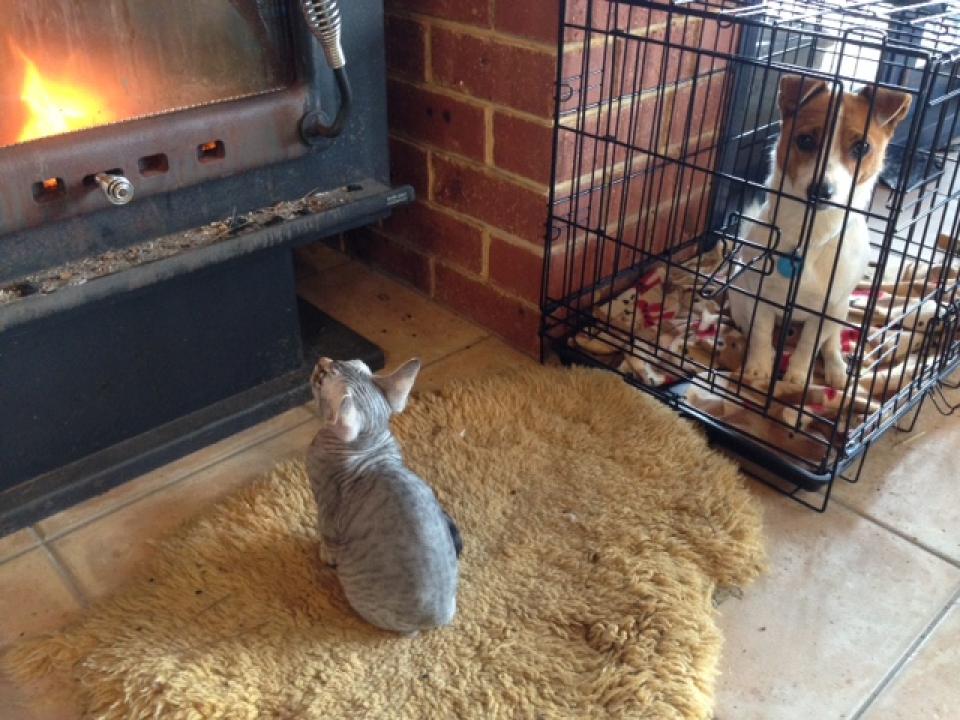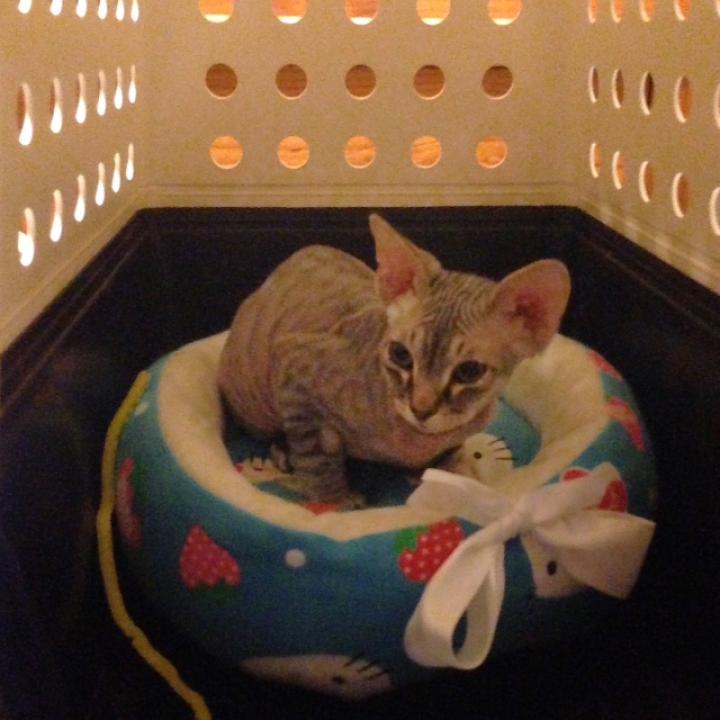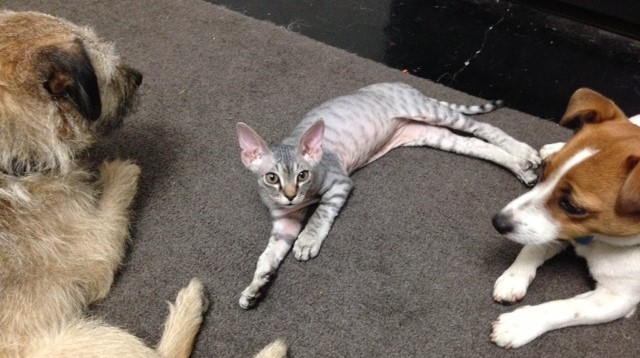Updated November 29, 2020
I’ve spent the last month introducing my new kitten Grendel to our dogs. Let me tell you, it’s not easy.
Most of us love having dogs and cats in our lives. This means we often expect these two different species to get along. It doesn’t happen automatically and if it’s not handled well it can end very badly. Here are some key points to remember.
Supervise. Supervise. Supervise.
Bad things happen quickly. Scared cats have a knack of aiming at a puppy’s eyes. Dog bites inflicted in a split second can be devastating. Therefore, above all, have your full attention on the dog and cat when they are together until you are certain they will get along.
Think Bruce the Shark from Finding Nemo. A pet can be told over and over again that the newcomer is ‘friend not food’ but instinct is always just beneath the surface. Cats lash out if approached too quickly and dogs can chase and nip if a cat runs.
Know Your Pets
If a dog or cat has been raised with the other species, they usually don’t need much training to accept a newcomer. Both our dogs lived with a cat from puppyhood so it hasn’t been too hard.
However, if an adult dog or cat with no previous experience is asked to accept a new arrival, be prepared for a long process. Sometimes it will simply not work, especially with rescue animals or when multiple dogs develop a pack mentality.
The breed of your existing pet can make a big difference. Terriers (like my two) have a strong predatory instinct and cats find them especially difficult. Also be careful with Arctic breeds and sighthounds (e.g. greyhounds). Usually, dogs known to be good with children are better with cats; read our top 20 family dog breeds but there are plenty of others too.
Cats like the Burmese, Siamese, Birman and Ragdoll are known for their sociability and reduced fear. These breeds often get on well with dogs.
Start Early
In the video you will see Grendel at only 9 weeks of age being exposed to Loki at the breeder’s house. We were lucky that they understood the importance of early socialisation in cats. Kittens are most easily habituated to the presence of dogs if exposed before 9 weeks of age. Kittens from shelters are usually available from 8 weeks but purebred cats rarely before 12 weeks old.
It’s a lot easier with puppies. They continue to socialise and habituate to other species up to 16 weeks of age. This, by the way, is one of the major changes between dogs and their wolf ancestors.
By starting early, kittens and puppies are more likely to accept the other animals as part of their social group, rather than threats or prey.
Keep Privileges
If you need to make changes to your established pet’s lifestyle, do it well before the new pet arrives. It’s really important to make sure they still get all the same attention, treats and access to favourite places. That way they won’t associate the newcomer with losing privileges. Continuing to walk dogs also means they may be more tired out before introducing a kitten.
Go Slowly & Patiently
Things don’t happen quickly and there’s a chance of major setbacks if you go too fast. Expect slow steps and plan only short intervals when you bring your pets together. Look for the earliest signs of stress and separate them if so.
Use Confinement
When your new dog or cat arrives, don’t be in a rush to mix everyone together. A cat is better off exploring the house on their own until they are confident in their new territory. Puppies have more trouble staying away from cats. Here it’s a good idea to regularly give the puppy time out in a crate or separate area. We think a puppy will benefit from crate training.

Keeping your new pet in one room for a few days allows the others to adjust gradually to their presence. Mix their odors by patting each other and sharing bedding, and if possible, keep the door open a few cm so that the animals can see each other.
Use crates and cat boxes for both dogs and cats at times and leashes for dogs. Confining either the newcomer or the established pets allows the free animal to explore at their own speed and retreat when they wish. This gives them the extra confidence to get to know each other safely. It’s also usually a good idea to only have two animals together at a time.
Use Treats
Make the new arrival a positive experience by providing positive rewards when your pets are together and well behaved. At the same time, try to avoid the new pet getting access to toys and items treasured by the established pet.
Treats can also be favourite toys and places. For example, many pets will tolerate others close by to get prime access to the heater or a lap.
Create Escape Areas
Once the pets are together, provide places that each of them can escape to for safety or privacy. Dogs are very good at learning to stay out of certain rooms if reminded and cats can jump out of reach. These are both good places to put their food, water and toilet.
Older cats like my The Puss may never accept a new puppy; for her we designated a part of the house out of bounds to dogs where she could retreat when she felt threatened.

To finish, it’s worth saying that getting cats and dogs to live with other species is a lot harder. Cats and dogs are predators to rabbits, rats, guinea pigs and birds; even though there are individual successes (particularly with large rabbits and cats), it’s asking too much to expect things to go well.
I hope I haven’t put anyone off taking the plunge. The main thing is patience. It’s a lot of work, but you should succeed and there’s something grand about having two species enjoy each other’s company. Just like we do with our pets!
Related: Introducing Kittens to Cats
Have something to add? Comments (if open) will appear within 24 hours.
By Andrew Spanner BVSc(Hons) MVetStud, a vet in Adelaide, Australia. Meet his team here.


We got our new rottie FM puppy @ 3 months , she is 8 months now but still wants to chase if they my three cats 2 Russians and a big black and white 2 yo moggy , Ducatti , now Billie the puppy loves Ducatti, and when Ducatti lets her get near whilst on a chair Billie licks and licks him
Ducatti gets fed up and hits her on the top of the head if he dosent get a back off he bites her on the top of her her nose Billie just keeps loving him regardless It she has never growled of tried to nip or bite .,we have baby gates on entry and exit to family area , cats have the top end of the house and a catio as well they are spoilt ,any advice please we are desexing Billie when she is a year old ,she is finishing her first heat at the moment our Rockie passed two weeks b4 we got Billie he loved the cat’s especially Ducatti they sometimes slept together I think Ducatti was lost when Rockie passed from Osteo sarcoma at 8 years he was desexed at 6 years he was a polite amazing Rottweiler so obedient ,
He was given to us at 6 by his former owner he did a great training of him , we have had 7 rescue dobermans and two Rottweilers in our 50 years of marriage they were all great dogs that lived on our 20 acres with horses ,sheep and cats
I started Billie in a Harness but at 6 months swapped to a choker chain as she was getting unruly with excitement on meeting new people.
Our vet nurse said to go into a choker as she will get too strong , she walks on a loose lead sits stays wait all those things except the meeting people and other dogs not mean just wants to play .we live in an isolated place so we don’t get to see people much and only farm dogs on farmers tray as they go past Advice please Thankyou so much
Hi Patricia. I don’t have any more advice I can give you I’m sorry. If the article doesn’t give you clear instructions, seek the advice of an experienced positive dog trainer.